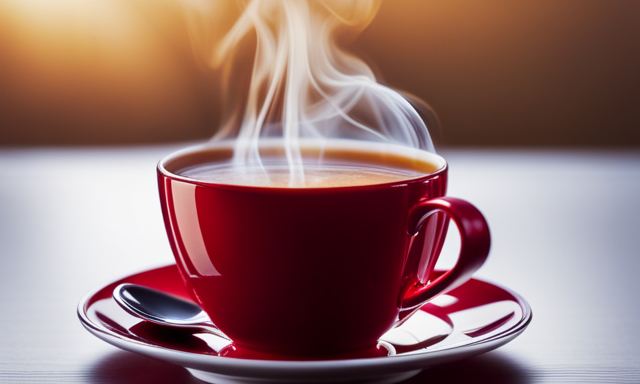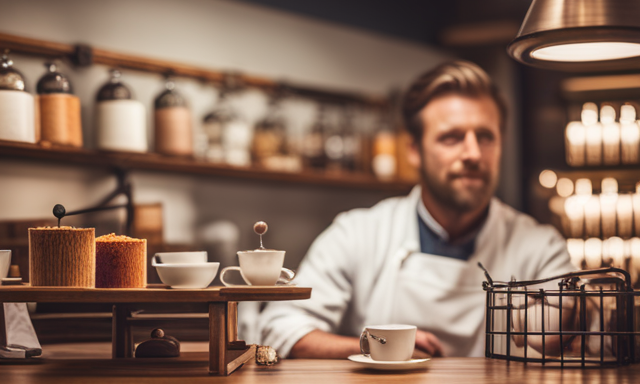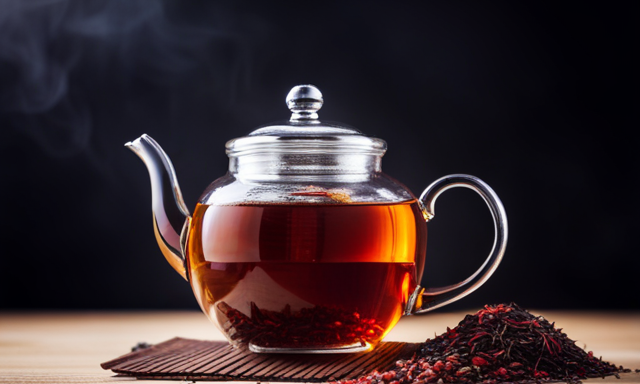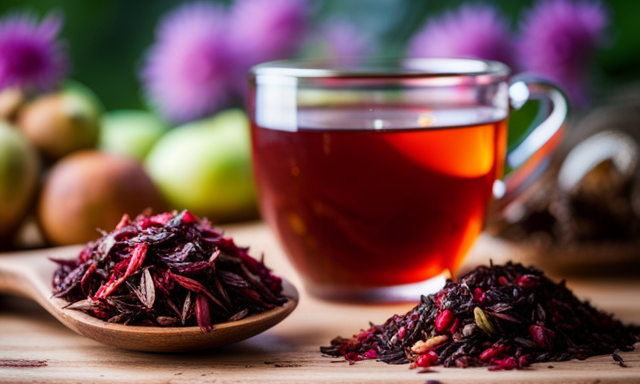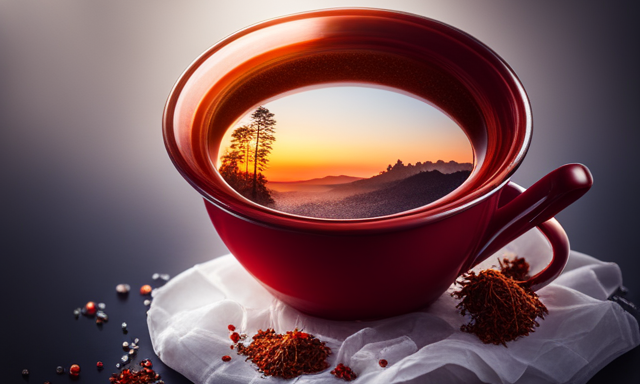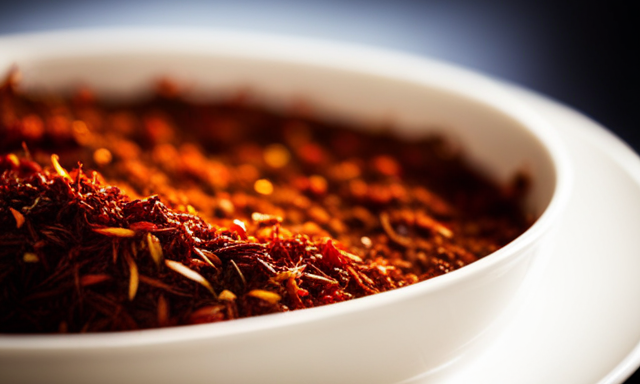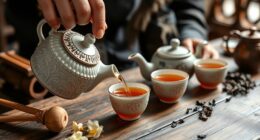I’ve always believed that the key to a perfect cup of tea lies in the temperature. And when it comes to rooibos tea, getting the temperature just right is crucial for unlocking its full flavor and aroma.
That’s why I’m here to share with you the optimal temperature for brewing this delicious herbal tea. But before we dive into the specifics, let’s take a moment to understand what makes rooibos tea so unique.
Known for its rich, earthy taste and numerous health benefits, rooibos tea has gained popularity all around the world. However, many people overlook the importance of temperature when brewing this beverage.
In this article, we will explore the factors that influence temperature choice, provide recommendations for the perfect brewing temperature, and offer tips to avoid common temperature mistakes.
So grab your favorite mug and let’s embark on a journey to brew the perfect cup of rooibos tea together.
Key Takeaways
- The optimal temperature for steeping rooibos tea is 203°F (95°C) for the best flavor.
- Using a temperature-controlled kettle or thermometer ensures the ideal steeping temperature.
- Steeping at the right temperature prevents bitterness and astringency in rooibos tea.
- Rooibos tea is forgiving and can be steeped using boiling water or slightly below boiling point.
Understanding Rooibos Tea
Rooibos tea, with its unique flavor and health benefits, is best enjoyed when brewed at a specific temperature. Understanding the health benefits of rooibos tea can help you appreciate why brewing it at the right temperature is crucial.
Packed with antioxidants, this tea is known to boost the immune system, improve digestion, and promote healthy skin. It’s also caffeine-free, making it a great choice for those looking to reduce their caffeine intake.
Additionally, rooibos tea can be used in various recipes, such as iced tea, tea lattes, and even cocktails.
When it comes to brewing this tea, temperature plays a vital role. In the next section, we will explore the importance of temperature in brewing and how it affects the flavor and aroma of rooibos tea.
The Importance of Temperature in Brewing
To achieve the perfect brew, you’ll want to ensure the water reaches the ideal temperature to bring out the full flavor and richness of your delightful cup. Temperature plays a crucial role in extracting the best qualities from your rooibos tea leaves.
Different brewing techniques call for different temperature preferences, so it’s essential to know which one suits your taste. Generally, rooibos tea is best brewed at a temperature between 200°F and 212°F (93°C – 100°C). This allows the flavors to fully develop without extracting any bitterness. However, if you prefer a milder taste, brewing at a slightly lower temperature, around 180°F (82°C), can also yield a delicious cup.
Now that we understand the importance of temperature in brewing, let’s dive into the recommended temperature for rooibos tea.
Recommended Temperature for Rooibos Tea
If you want to experience the full flavor of your cup of rooibos, try brewing it at a temperature between 200°F and 212°F (93°C – 100°C) – it’s the sweet spot for maximum taste satisfaction! The recommended temperature for brewing rooibos tea is crucial in bringing out its unique characteristics. Rooibos is a delicate tea that requires careful handling to extract its rich flavors. Brewing rooibos at a lower temperature may result in a weak and bland cup, while brewing it at a higher temperature can lead to a bitter taste. To help you understand the importance of temperature in brewing rooibos tea, here is a table that showcases the recommended temperature range and brewing techniques for optimal results:
| Temperature (°F) | Temperature (°C) | Brewing Technique |
|---|---|---|
| 200-212°F | 93-100°C | Steep for 5-7 minutes |
By following these recommended temperature guidelines and employing proper brewing techniques, you can ensure a delightful cup of rooibos tea. Transitioning into the next section about factors influencing temperature choice, it is important to consider various elements that can impact the temperature selection.
Factors Influencing Temperature Choice
When it comes to brewing the perfect cup of rooibos, there are several factors that can influence your choice of temperature. Here are three key factors to consider when deciding on the temperature for your rooibos tea:
-
Flavor Extraction: Higher temperatures, around 200°F (93°C), allow for a quicker extraction of flavors from the rooibos leaves. This results in a stronger and more robust cup of tea.
-
Aroma Preservation: Lower temperatures, around 180°F (82°C), help to preserve the delicate aromas of rooibos tea. This allows for a more subtle and nuanced experience, with the fragrance of the tea being more pronounced.
-
Personal Preference: Ultimately, the choice of temperature boils down to personal preference. Some people may prefer a stronger and bolder cup, while others may enjoy a milder and more fragrant brew.
Considering these factors, you can now make an informed decision about the temperature that best suits your taste preferences and desired flavor profile. Achieving optimal flavor and aroma requires careful consideration of not only temperature but also other brewing techniques.
Achieving Optimal Flavor and Aroma
In order to achieve the perfect flavor and aroma in your cup of red bush, it’s important to carefully consider factors such as brewing time and water quality. Achieving the right balance of flavor and aroma requires attention to detail.
First, make sure to steep your rooibos tea for the recommended amount of time, usually around 5-7 minutes. This allows the flavors to fully develop without becoming bitter.
Additionally, using high-quality water is essential, as it can greatly impact the taste of your tea. Filtered water or spring water is often recommended to avoid any unwanted flavors or impurities.
Lastly, be mindful of the water temperature. While rooibos tea can be brewed with boiling water, some prefer a slightly lower temperature, around 200°F, to bring out a smoother flavor. Experimenting with different temperatures will allow you to find your preferred balance of flavor and aroma, making each cup of rooibos tea a delightful experience.
Experimenting with Different Temperatures
Try experimenting with different water temperatures to find the perfect balance of flavor and aroma in your cup of red bush. Temperature variations can have a significant impact on the taste and fragrance of your rooibos tea. Start by brewing a cup at the recommended temperature of 200°F (93°C), and take note of the flavors and aromas that come through.
Then, try brewing another cup at a slightly lower temperature, around 180°F (82°C), and compare the results. You may find that the lower temperature brings out different nuances and subtleties in the tea. On the other hand, if you prefer a stronger flavor, you can try brewing at a higher temperature, such as 212°F (100°C). By comparing the results, you can determine which temperature brings out the flavors and aromas that you enjoy the most.
Now, let’s move on to avoiding common temperature mistakes without compromising the taste of your rooibos tea.
Avoiding Common Temperature Mistakes
To ensure the perfect brew, it’s essential to sidestep common temperature mistakes when preparing your favorite cup of red bush. Achieving optimal flavor relies heavily on getting the temperature just right.
One common mistake is using boiling water for rooibos tea. This can result in a bitter and harsh taste. Instead, aim for a water temperature of around 200°F (93°C).
Another mistake to avoid is using water that is too hot. Steeping rooibos tea in water that’s too hot can extract unwanted tannins and make the tea taste astringent. It’s important to find the balance between a hot enough temperature to extract the flavors and a temperature that doesn’t overpower the delicate nature of rooibos tea.
By avoiding these common temperature mistakes, you can ensure a flavorful and enjoyable cup of rooibos tea.
Moving on to the next section about using the right equipment for temperature control, let’s explore how to achieve the perfect brew.
Using the Right Equipment for Temperature Control
Now that we’ve covered some common temperature mistakes to avoid, let’s talk about using the right equipment for temperature control when brewing rooibos tea.
Temperature control is crucial for achieving the perfect cup, as different types of tea require specific temperatures to bring out their flavors and aromas. When it comes to rooibos tea, using a temperature-controlled kettle or a thermometer can ensure that you steep it at the ideal temperature of 203°F (95°C). This will allow the tea leaves to release their full potential without becoming bitter or astringent.
Additionally, using a teapot with a built-in infuser or a fine mesh strainer will help you achieve a consistent brew.
Now, let’s move on to other tips for brewing the perfect cup of rooibos tea, where we’ll explore additional techniques to enhance your tea-drinking experience.
Other Tips for Brewing the Perfect Cup of Rooibos Tea
For an exquisite cup of rooibos tea, ensure you have the right brewing time and method in order to savor the full richness and warmth of this beloved beverage. When it comes to brewing techniques, rooibos tea is quite forgiving. It can be steeped using boiling water or water that is slightly below boiling point, around 195°F (90°C). Steeping for about 5-7 minutes will extract the best flavor from the tea leaves. However, if you prefer a stronger brew, you can increase the steeping time to 10 minutes. Rooibos tea offers a range of flavor profiles, from earthy and nutty to fruity and floral, depending on the variety and any added ingredients. Experimenting with different brewing times and temperatures can help you discover your preferred flavor profile. Transitioning into the next section, enjoying the benefits of rooibos tea is a delightful way to incorporate wellness into your daily routine.
Enjoying the Benefits of Rooibos Tea
Indulge yourself in the myriad of health benefits that can be derived from savoring the exquisite flavors of this beloved South African herbal infusion. Rooibos tea isn’t just a delicious beverage, but it also offers a wide range of benefits for your well-being. By brewing it properly, you can maximize its health benefits and fully enjoy its unique flavors.
One of the great things about rooibos tea is that it’s naturally caffeine-free, making it a perfect choice for those looking to reduce their caffeine intake. It’s also rich in antioxidants, which can help protect your body against oxidative stress and promote overall health.
To explore different flavors, you can experiment with various additions like lemon, honey, or even spices like cinnamon or ginger. These additions don’t just enhance the taste but also provide additional health benefits.
So, why not treat yourself to a cup of rooibos tea and experience the incredible benefits it has to offer? Cheers to your health!
Frequently Asked Questions
Can I use boiling water to brew rooibos tea?
Boiling water is not recommended for brewing rooibos tea. The ideal temperature range is 195-210°F. Using boiling water can result in a bitter taste, so it’s best to steep rooibos tea at a slightly lower temperature for optimal flavor.
What is the ideal temperature range for brewing rooibos tea?
The ideal brewing time for rooibos tea is 5-7 minutes, and the best water temperature is 205-212°F (96-100°C). This ensures a flavorful and aromatic cup of tea.
Can I cold brew rooibos tea?
Absolutely! Cold brewing rooibos tea is a delightful experience. Not only does it unlock a unique flavor profile, but it also offers numerous benefits like lower caffeine content and smoother taste compared to hot brewing methods.
Does the water temperature affect the health benefits of rooibos tea?
Water temperature does affect the health benefits of rooibos tea. The ideal temperature for brewing is between 200-212°F. This temperature allows for the extraction of antioxidants and other beneficial compounds, maximizing the tea’s health benefits.
Are there any alternative methods for controlling the water temperature when brewing rooibos tea?
When it comes to controlling the water temperature for brewing rooibos tea, there are various alternative methods available. These innovative techniques allow for precise control over the water temperature, ensuring a perfect cup every time.
Conclusion
So, there you have it! The perfect temperature for brewing a delightful cup of rooibos tea. Who knew that something as simple as temperature could make such a difference in taste?
Now that you’re armed with this knowledge, you can impress your friends with your tea-making skills. Just remember, if you want to enjoy the full flavor and aroma of rooibos tea, don’t forget to pay attention to the temperature.
Cheers to a perfectly brewed cup of irony-infused rooibos tea!

